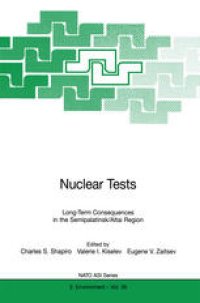
Ebook: Nuclear Tests: Long-Term Consequences in the Semipalatinsk/Altai Region
Author: Dr. Peter J. Coughtrey (auth.) Charles S. Shapiro Valerie I. Kiselev Eugene V. Zaitsev (eds.)
- Tags: Effects of Radiation/Radiation Protection, Environmental Health, Cancer Research, Atmospheric Protection/Air Quality Control/Air Pollution, Nuclear Physics Heavy Ions Hadrons, Nuclear Fusion
- Series: NATO ASI Series 36
- Year: 1998
- Publisher: Springer-Verlag Berlin Heidelberg
- Edition: 1
- Language: English
- pdf
This volume focuses on the human exposures and medical effects studies in the SemipaiatinskJ Altai region of Siberia that were a consequence of the radioactive fallout from nuclear test explosions that took place at the Semipalatinsk Test Site of the former Soviet Union. It contains a detailed account of a NATO Advanced Research Workshop (ARW) devoted to the subject, and a selection of the papers presented. The title of the ARW was "Long-term Consequences of Nuclear Tests for the Environment and Population Health (SemipaiatinskJAltai Case Studies)". The estimated exposures to large numbers of people in the Altai lie in an important dose rate and dose domain. Hence the research reported herein provides new and unique information on the effects of radiation on humans. Also emphasized at the ARW were studies involving fallout from the Pacific Island tests of the U. S. A . . There have been over 2300 nuclear weapon test explosions to date. More than 500 took place in the atmosphere and outer space; the remainder were underground. The atmospheric tests comprise the largest source of anthropogenic radioactivity released into the earth's atmosphere to date. The vast majority, in number and yield, were carried out by the former Soviet Union (FSU) and the United States. Each superpower maintained two primary test sites, one continental primarily for small yield tests, and the other more remote for larger yield tests. For the U. S. A.
The first Soviet atomic bomb test, which took place at Semipalatinsk in Kazakhstan on 29 August 1949, was the most egregious test by far in terms of collective exposures to local fallout. This volume is devoted to this first, and to further nuclear weapon test explosions in the Semipalatinsk/Altai region. It analyses the environmental and human consequences of the radioactive fallout and presents detailed accounts, never published before in the West, of the methodologies of Russian scientists in source term analysis, dose reconstruction, and medical effects studies.
The first Soviet atomic bomb test, which took place at Semipalatinsk in Kazakhstan on 29 August 1949, was the most egregious test by far in terms of collective exposures to local fallout. This volume is devoted to this first, and to further nuclear weapon test explosions in the Semipalatinsk/Altai region. It analyses the environmental and human consequences of the radioactive fallout and presents detailed accounts, never published before in the West, of the methodologies of Russian scientists in source term analysis, dose reconstruction, and medical effects studies.
Content:
Front Matter....Pages I-XI
Report of the Scientific Secretary....Pages 1-16
Overview of the NATO/SCOPE-RADTEST Advanced Research Workshop in Barnaul, Siberia....Pages 17-88
Chronological List of Nuclear Tests at the Semipalatinsk Test Site and Their Radiation Effects....Pages 89-97
On the Possibility of Identifying Nuclear-Explosion Radioactive Patterns and Reconstructing Population-Exposure Doses Using the Analysis of Long-Lived Radionuclides....Pages 99-105
Estimation of the Altai Region Population Exposure Resulting from the Nuclear Tests at the Semipalatinsk Test Site....Pages 107-132
Basis of the Retrospective Reconstruction Method for Parameters Determining Internal Irradiation Along the Trace Following a Nuclear Explosion....Pages 133-147
Initial Approaches to the Establishment of a Russian Data Bank on Nuclear Explosions and Compatibility with Similar Foreign Data Banks....Pages 149-155
Estimation of Long-Term Consequences of Nuclear Tests at the Semipalatinsk Test Site for the Altai Population....Pages 157-185
Back Matter....Pages 187-196
The first Soviet atomic bomb test, which took place at Semipalatinsk in Kazakhstan on 29 August 1949, was the most egregious test by far in terms of collective exposures to local fallout. This volume is devoted to this first, and to further nuclear weapon test explosions in the Semipalatinsk/Altai region. It analyses the environmental and human consequences of the radioactive fallout and presents detailed accounts, never published before in the West, of the methodologies of Russian scientists in source term analysis, dose reconstruction, and medical effects studies.
Content:
Front Matter....Pages I-XI
Report of the Scientific Secretary....Pages 1-16
Overview of the NATO/SCOPE-RADTEST Advanced Research Workshop in Barnaul, Siberia....Pages 17-88
Chronological List of Nuclear Tests at the Semipalatinsk Test Site and Their Radiation Effects....Pages 89-97
On the Possibility of Identifying Nuclear-Explosion Radioactive Patterns and Reconstructing Population-Exposure Doses Using the Analysis of Long-Lived Radionuclides....Pages 99-105
Estimation of the Altai Region Population Exposure Resulting from the Nuclear Tests at the Semipalatinsk Test Site....Pages 107-132
Basis of the Retrospective Reconstruction Method for Parameters Determining Internal Irradiation Along the Trace Following a Nuclear Explosion....Pages 133-147
Initial Approaches to the Establishment of a Russian Data Bank on Nuclear Explosions and Compatibility with Similar Foreign Data Banks....Pages 149-155
Estimation of Long-Term Consequences of Nuclear Tests at the Semipalatinsk Test Site for the Altai Population....Pages 157-185
Back Matter....Pages 187-196
....